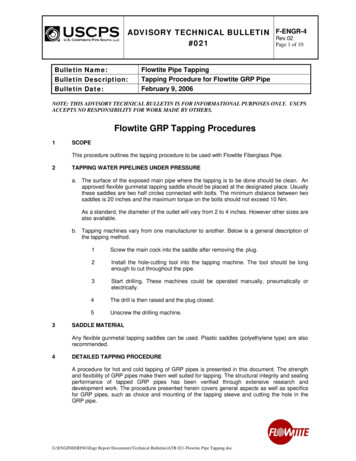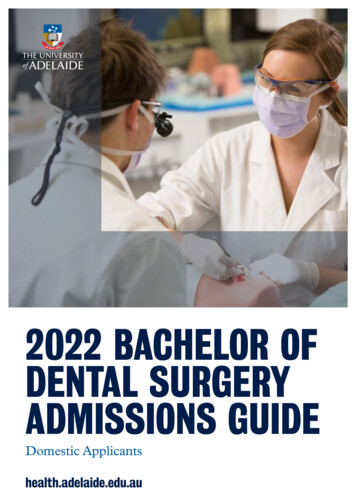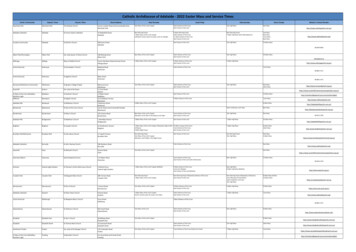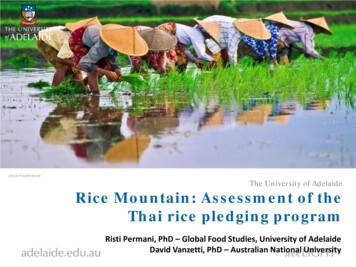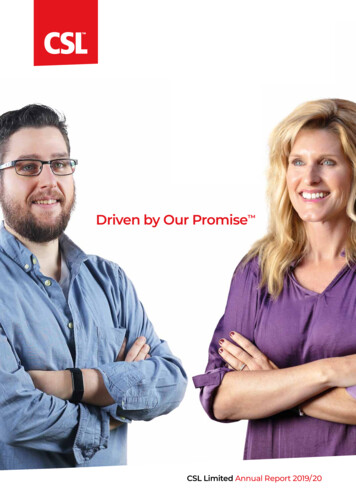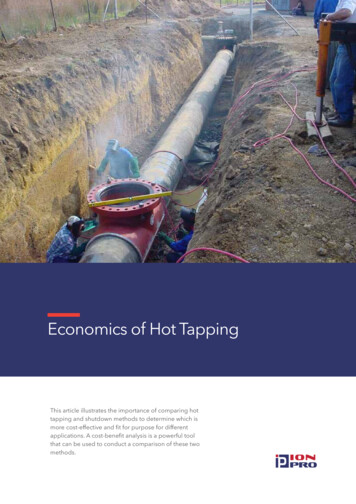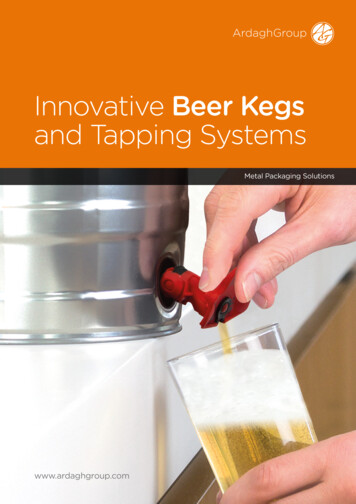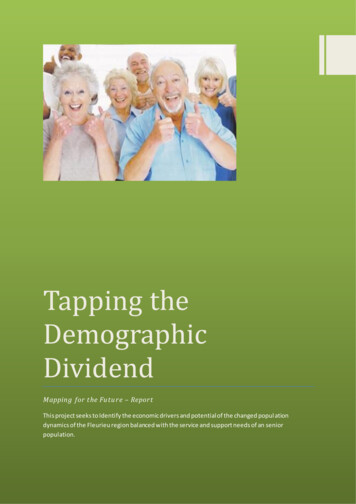
Transcription
Ageing and Economic Development for the FleurieuProject Plan 2015-18Tapping theDemographicDividendMapping for the Future – ReportThis project seeks to Identify the economic drivers and potential of the changed popul ationdynamics of the Fleurieu region balanced with the service and support needs of an seniorpopulation.Page 1 of 59
Tapping the Demographic DividendMapping for the Future ReportCreation Date:21th August 2015Created by:Johanna Milbankjohannam@rdahc.com.auReview Date:Version:V1Regi onal Development Australia Adelaide Hills Fleurieu & Ka ngaroo IslandAugus t 2015Pa ge 2 of 59
Tapping the Demographic DividendMapping for the Future ReportTable of ContentsExecutive Summary. 5Introduction . 7Background . 8Project Objectives. 9Project Methodology . 10Alignment with Current Activities and Initiatives. 11National and State Plans and Reports . 11Local Plans and Reports . 15Community & Business Profile . 18Summary of Data . 18Population . 20Workforce Data. 23Business and Industry . 29Education . 36Volunteering . 41Aged Care and Community Care Workforce . 44Community Programs. 46Value Chain. 48Aged Care Sector Comments . 48General Comments. 48Recommendations and Actions . 49References . 50Appendices . 52Appendix 1: Summary of Council Plans and Services . 52Summary of Council’s Plans . 52Summary of Health and Well-being Facilities and Services . 54Appendix 2: Meeting Needs of SA’s SASP, Strategic & Economic Priorities . 56State Economic Priorities . 56Strategic Priorities: . 56Relevant SASP Targets: . 57Appendix 3: Interviews and Other Information Sources. 58Regi onal Development Australia Adelaide Hills Fleurieu & Ka ngaroo IslandAugus t 2015Pa ge 3 of 59
Tapping the Demographic DividendMapping for the Future Report1. The demographic dividend is the accelerated economic growth that may result from a decline in acountry's mortality and fertility and the subsequent change in the age structure of the population.Population Reference /demographic-dividend.aspxThis dividend period generally lasts for a long time - typically five decades or more. Eventually, however,the reduced birth rate reduces the labor force growth. Meanwhile, improvements in medicine andbetter health practices leads to an ever-expanding elderly population, sapping additional income andputting an end to the demographic erms/d/demographic-dividend.aspAs a result of a “first” demographic transition, age structures of populations become older.Economically, people often move into higher-paying jobs and countries experience higher per capitaincome. These social and economic changes motivate people to accumulate greater personal wealth—aprocess known as the “second” demographic dividend.If the right policies are in place, population aging can yield a second dividend, one that can be longlasting and larger than the first dividend.Beyond the First Dividend: Sustaining the Second Demographic Dividend (2013), Population ReferenceBureau dividend.pdfRegi onal Development Australia Adelaide Hills Fleurieu & Ka ngaroo IslandAugus t 2015Pa ge 4 of 59
Tapping the Demographic DividendMapping for the Future ReportExecutive SummaryThrough our Tapping in to the Demographic Dividend program we are working to identify anddevelop opportunities that will both enhance the experience for the Fleurieu’s senior populationwhile providing greater economic opportunities.Through the first year of the project a number of areas of investigation were reviewed including: Federal, State and local government policies with regard to the senior populationAged care and home and community care industriesAwareness of positive ageing and age friendly communities including dementia awarenessDemographic data of the senior populationAreas of potential commercial and community opportunitiesOrganisations that work for or with the senior population including aged and communitycare, general businesses, community organisations and local governmentThe main National and State themes identified are: Entrepreneurship and innovation as a way to engage or keep seniors active in thecommunity and for economic developmentMentoring and other programs that tap into the experience, skills and knowledge of thesenior populationEngagement and activity of senior people living in the community and its contribution tohealth and well-beingFood and nutrition as a contributing factor to health and well-beingGood planning and policy decisions that support senior peoples continued engagement andcontribution to the community including urban design, commercial products, technologyuse, social and community support services and programs and activities; andIntergenerational programs and activities that provide greater connectivity between oursenior population and younger cohorts and reduced duplication and encourages better useof resourcesMain local findings are: There is strong engagement of senior people within the Fleurieu region including throughvolunteering and industry and business but there remain individuals that are socially isolatedand access to some services can be problematicThere remains discrimination in employment of senior people and while awareness of theneeds of seniors is increasing among businesses both as customers and employees there isstill many that do not yet consider how they may better meet the needs of this cohortThere are many senior business owners but potential for greater entrepreneurial activityacross all age groups but also for senior people to not only utilise their skills and knowledgeand keep them active in the community but as additional income and supplementary incometo preserve retirement savingsSenior people seem open to undertaking training and learning but are prohibited by cost,and availability. Senior people can be also overlooked with regards to professionaldevelopment and learning within the workplace.There is a gap between youth and senior people where many benefits could be seen if moreintergenerational activities were encouraged. There is also considered to be an untappedresource of skills and knowledge within the senior population that could be better utilised bythe community and for local economic development.Regi onal Development Australia Adelaide Hills Fleurieu & Ka ngaroo IslandAugus t 2015Pa ge 5 of 59
Tapping the Demographic DividendMapping for the Future Report There is no single point of information coordination within the Fleurieu region though TheTimes Community guide produced annually provides a directory of organisationsThere is greater potential for innovation especially around the senior cohort that is notcurrently being capitalised on. Increasing the awareness of innovation leading to thegeneration of new business ideas, new products and services. Support to implement thesetypes of activities within businesses is required and includes better linkages to governmentand research organisation outside the region to assist in this processThrough this research several areas of action for the project over the next couple of years has beenidentified:1. Utilising the latent talent in our region for both social and economic benefit including:Innovation and entrepreneurshipSupport senior entrepreneur’s by working inpartnership with UniSA’s SeniorpreneursProgram, CEGA’s Mature Aged BusinessSyndicates with TAFESA and EconomicDevelopment Officers with each of the localgovernment associationsMentoring and skills matching to business andcommunity needsResearch and develop a mentoring model forboth community and commercial applicationutilising the latent knowledge of local seniorsand encouraging skills / project basedvolunteering opportunities2. Awareness and promotion of changing needs and customer dynamics of the seniorpopulation across both the commercial and community sectors by:Innovation and business growth opportunitiesfor local businesses and the regionBuild local business knowledge aroundchanging customer dynamics and undertakefurther qualitative market research of whatseniors in the region want and needRealign commercial services to be industryleaders in this segmentDevelop three pilot projects working with localbusinesses to capitalise on market gaps andareas of opportunities3. Further support for the above two areas of action will be provided by:SupportEncourage intergenerational activities andlifelong learning within the regionPromotion and awareness raising of agefriendly communitiesDeliver the Flourishing in the Fleurieu AgeFriendly Business and Community AwardsContinue to work with and support theSouthern Fleurieu Positive Ageing TaskforceDeliver an annual Business and CommunityforumRegi onal Development Australia Adelaide Hills Fleurieu & Ka ngaroo IslandAugus t 2015Pa ge 6 of 59
Tapping the Demographic DividendMapping for the Future ReportIntroductionThe Fleurieu over the last couple of decades has seen the decline in its manufacturing industry.Agriculture while still prevalent can struggle and while it still remains one of the regions strengthscontinues to see pressure. Tourism continues to be a significant driver of regional economic activity.The state government has identified the south coast (Goolwa to Victor Harbor) as a significantgrowth centre. Populations could double over the next thirty years. This has left the region in aposition of needing new industry(s) to provide the foundation for a strong region.The region is ageing; more than half of the population is over 50. These changes in populationdemographics are key to identifying potential new areas for this region that will provide economicstimulus and employment over the longer term.It is clear that senior Australians are not a homogeneous group with the same needs. Using thesouth coast as an example there may be at least three groups. Semi or newly retired who are activeand independent, senior retired who are still independent but not so active, and a group who need asignificant amount of support.In short, we are ageing as a nation and the Fleurieu as a beautiful region has attracted a highpercentage of senior people. This project aims to enhance this experience for all concernedidentifying ways the region can support this population to the benefit of all groups and how theregion can benefit from such a resource.Regi onal Development Australia Adelaide Hills Fleurieu & Ka ngaroo IslandAugus t 2015Pa ge 7 of 59
Tapping the Demographic DividendMapping for the Future ReportBackgroundThe Fleurieu Region is comprised of the three local government areas of Alexandrina, Yankalilla andVictor Harbor councils with a total population of about 42,000 people.Victor Harbor and Goolwa within this region are described as retirement destinations with significantpopulation growth in the senior age brackets as senior people and retirees have moved to the regionfor both a ‘sea’ and/or ‘tree’ change. This has provided growth in residential construction but alsowill require the infrastructure and services to support this senior population.Khan H (2013) says “Today’s 60 year old may bethinking and feeling more like a 50 year old ageneration ago. Longer lives mean many moreopportunities to live, to learn and to go enjoy and anend to the 20th century’s vice of what Michael Youngcalled ‘chronologism’: the assumption thateducation, work and retirement should all beprescribed according to our chronological age.” KhanH (2013) also writes though that “every society willhave a large and growing number of people living withlong-term conditions and disabilities.” This means thatwhile we are living longer there are many challengesto supporting our senior populations. Khan asksquestions such as “how to fill the extra years usefully;how to provide care; how to reshape housing, orurban design and how to rethink savings and pensionsso that people aren’t left impoverished at the end oftheir lives”.“Today’s 60 year old may be thinking and feeling morelike a 50 year old a generation ago. Longer lives meanmany more opportunities to live, to learn and to goenjoy and an end to the 20 th century’s vice of whatMichael Young called ‘chronologism’: the assumptionthat education, work and retirement should all beprescribed according to our chronological age.”Khan H (2013)“With higher superannuation savings in the nearterm and with increasing expectations and needs,the consumption potential of older residents willdrive an increased demand for goods and servicesthat accommodate their income and lifestylepreferences”Sappery J et al (2010)To add Sappery J et al (2010) writes that there are increasing expectations of senior populations inhaving their needs met: “With higher superannuation savings in the near term and with increasingexpectations and needs, the consumption potential of senior residents will drive an increaseddemand for goods and services that accommodate their income and lifestyle preferences”. Thispresents the Fleurieu region in particular with a growing opportunity in developing services andbusinesses that cater for the expectations of this significant population cohort.Community based as well as commercial aged care providers all play a role in supporting thispopulation but other areas of opportunity also exist. These include the development of specificproducts and services in the commercial sector such as: food and beverage,tourism, recreation and leisure,equipment and physical infrastructure both at the personal, home and community level,transport and accesscommunity planning and design,personal and home services (beauty to gardening and handyman services)Regi onal Development Australia Adelaide Hills Fleurieu & Ka ngaroo IslandAugus t 2015Pa ge 8 of 59
Tapping the Demographic DividendMapping for the Future Report financial managementArts and cultureThis project seeks to work with and build on the work undertaken by the Southern Fleurieu PositiveAgeing Strategy across Alexandrina Council, City of Victor Harbor, and Yankalilla Council areas, withnetwork links extending to Kangaroo Island. The Taskforce facilitates service reform and aims toimprove regional service cooperation and coordination around the aged care sector. The need forthese Positive Ageing projects was that significant proportions of each region’s population is aged 65years and over and with predicted increases in coming years. While the Taskforce acts strongly in theaged care sector and some impact in the community sector there is further support required forcommunity groups and other areas such as the commercial and business sectors.Other considerations for this project in laying a foundation for good policy and economicdevelopment are: Realign commercial services to be industry leaders in this segment including theidentification and support of innovation, entrepreneurship and business growthopportunities for local businesses and the region and how this plays a role in economicecosystems. Local government associations and Regional Development Australia both play arole in this area with guidance needed for future actions as to how this may be bestencouraged through good policy development and programs at the local and stategovernment level.Using the latent talent within the region ensuring good leadership, skills and knowledge isavailable to guide not only industry and associated businesses in a coordinated andcollaborative effort but also the region and to communicate the regional benefits that canbe achieved from such actionGiven the significant proportion of 65 years and senior people now residing in the Fleurieu region astrategic approach is needed to not only meet the needs of this cohort but also to identify and utilisethe opportunities that comes with that for the economic benefit of the region. This project hassought to gain a better understanding of the dynamics of the senior population, the aged care sectorand other service or potential services that utilise this senior population in some way.Project ObjectivesThe project proposes to gain a better understanding across the value chain of the senior populationas consumers and actors, the aged care sector and other products and service. This also includespotential services that provide support to this senior population. From this research greaterunderstanding for better policy and decision making can be made at the government level tosupport the region and its population and to inform business and industry where the potentialopportunities lie for future growth, innovation investment and economic diversity.Regi onal Development Australia Adelaide Hills Fleurieu & Ka ngaroo IslandAugus t 2015Pa ge 9 of 59
Tapping the Demographic DividendMapping for the Future ReportInformation sought and activities undertaken have included: current service levels – these have largely been assessed by the three councils through thePositive Ageing Taskforce but areas of less formal service like those delivered by communitygroups and volunteers have been looked at;gaps analysis will be targeted to business and other organisations who interact with thecohort especially in the area of design of products and services;Levels of interaction and support with local businesses and community that could facilitateincreased engagement of senior people in the community and access to other services andexperiences;expectation and what the senior population would like to see offered to assist in keepingthem active and engaged in the community; andpromotion and awareness of age friendly and positive ageing concepts. Project MethodologyQualitative and quantitative information was analysed in the generation of this report. Aspects ofvalue chain analysis was also utilized to identify where greater potential value could be found forbusinesses servicing this senior cohort in the community. Unlike traditional value chain analysis thatfocuses on a single industry or business this analysis focused on a particular customer group andextrapolated value back to industries and local businesses against their needs and expectations.A number of key groups have been identified within the senior population and will be the key targetgroups for this project:By activity levels and support needs: Active and independent retired or semi-retired individuals;Limited active and/or minor support need individuals; andThose who require significant supportOr by age groups: Those 50 to 64 years of age or pre-retirementThose 65 to 74 years of age; andThose 75 years of ageThree key areas have been identified for investigation around tapping into the economicdevelopment opportunities around these key target groups: Health and Aged Care / Community Care ServicesGeneral Business products and services (inc Sport, Rec and Leisure, Tourism)Community products and services (not-for-profit and volunteering)Self-actualisationRegi onal Development Australia Adelaide Hills Fleurieu & Ka ngaroo IslandAugus t 2015Pa ge 10 of 59
Tapping the Demographic DividendMapping for the Future ReportAlignment with Current Activities and InitiativesThere is much activity occurring around senior populations within Australia. The following reportsand organisations have been investigated with regard to activities and policy directions.Unfortunately, besides the Positive Ageing Projects occurring across a number of regions there islittle evidence of other regional activities from a State or Federal level. We can however use theseState and Federal initiatives as a guide for the region and to align our own activities with the viewstimulating greater collaboration and connectedness with metropolitan areas.National and State Plans and ReportsProsperity Through Longevity, South Australia’s Ageing Plan 2014-2019“To ensure South Australians have a fulfilling, active and enjoyable life at every age, gaining themaximum benefit from longevity linking personal wellbeing with social and economic productivity.”Key priorities that underpin this project are:1. Recognise seniors as vital drivers of the state’s social infrastructure and economy;2. Promote participation of seniors in civic life and support opportunities for lifelong learningand social and economic engagement;3. Support good urban and regional planning for user friendly environment that benefit allages; and4. Promote the value of intergenerational collaboration.The plan also emphasises that “A larger older population means a deeper pool of life and workexperience and skills developed over time. Learning from the examples of Aboriginal Elders, weknow that this is a great community and economic asset which should not be underrated in thebenefits for South Australia.”Other factors highlighted in South Australia’s Ageing Plan include: Financial - the link between socio-economic status and health outcomes and reports that theaverage (mean or median) income in households with a person aged 65 years and over islower than the national average and is also lower than the average equivalised householdincome of other age groups. This is further compounded by living cost indexes for agedpensions that continue to go up faster than Consumer Price Index (CPI);Health Status – good health helps to reduce the demands for health and aged care servicesand that current senior Australian’s today are generally healthier than previous generations;Carers – many senior people provide formal and informal assistance to others even thoughthey may themselves also be receiving assistance;Disability – Increased risk of disability is a factor of increasing age and often links with caringresponsibilities. Dementia is the single greatest cause of disability in senior Australians aged65 years and over.Value of participation – for both social and financial reasons, seniors need to stay involvedand whenever possible become more involved. Roles include as workers, consumers, smallRegi onal Development Australia Adelaide Hills Fleurieu & Ka ngaroo IslandAugus t 2015Pa ge 11 of 59
Tapping the Demographic DividendMapping for the Future Report business owners, volunteers, community members and tourists as well as parents,grandparents, neighbours, friends and carers;Technology and access to information – Clear differences between older age groups with themore senior age groups less comfortable than younger older people with new technologiesVolunteering – Volunteering is an important aspect of civic participation with the dualbenefit of sense of contribution and purpose for the individual as well as companionshipimproving well-being while also benefitting the community. South Australia has aboveaverage levels of volunteering compared to Australia overall.Lifelong learning – as a way to not only enhance social inclusion, active citizenship andpersonal development but also competitiveness and employability;Transport and mobility – Being able to safely and conveniently access shopping, medical,social and family is important in maintaining well-being.Active Aging AustraliaActive Aging Australia “promotes physical activity for a lifetime of health and well-being” as a way tosupporting individual’s ability to maintain independent, healthy lifestyles and continuedparticipation and contribution to communities. Active Ageing Australia have a number of projects :o AAAnet – a network for organisations with an interest in physical activity for senior adults tosource and share information and as a communication and collaboration tool;o Celebrate Age Conference held on 18th March 2016;o FallsSA – aimed at reducing the incidence of falls by provision of information forprofessionals and the public via a website;o 5 for 10 program – encouraged active lifestyle through participation in recreational sportand consists of 5 weekly sessions of modified (if required) activity for 10. Clubs interestedin becoming part of the 5 for 10 program can register to be part of this program. Theprogram is being run within South Australia and Adelaide but with particular focus on thecouncil areas of City of Onkaparinga and City of Victor Harbor. Out of 18 registrations for2015-16 six clubs from City of Onkaparinga and five from City of Victor Harbor and one fromCity of Victor Harbor / Alexandrina Council are registered to participate in the 5 for 10program.Per Capita, CAPPA and the Blueprint for an Ageing AustraliaPerCapita is one of Australia’s leading “think tanks” dedicated to building a new vi son for Australiabased on fairness, prosperity, community and social justice. The Centre for Applied Policy in Posit iveAgeing (CAPPA) is the “do tank” of Per Capita for positive ageing initiatives. In 2014 PerCapitaworked with a panel of experts to develop the “Blueprint for an Ageing Australia. The blueprintworks to promote “Ageing as a social and economic asset” and identified seven areas for new policydevelopment: Business Opportunities including:a. entrepreneurship and developing education and training around entrepreneurship andthe needs of seniorsb. encouraging skilled and experienced senior individuals to participate in mentorship andcoaching activitiesRegi onal Development Australia Adelaide Hills Fleurieu & Ka ngaroo IslandAugus t 2015Pa ge 12 of 59
Tapping the Demographic DividendMapping for the Future Report c. providing programs and tax incentives to encourage senior people into businessd. TAFE and universities offering courses specifically for senior peoplee. Launching design awards for innovation in creating new products and services for anageing marketplaceMature aged employment including:a. Making it easier to return to work after illness an injuryb. Providing health and well-being programsc. Reducing or eliminating discriminationd. Ensuring flexible working hours to accommodate caring responsibilitiese. Maintaining skills currency through training and reskilling programsPhilanthropyEnabling environments including:a. Affordable and well run public transportb. Accessible transport for those with mobility problemsc. Well maintained footpaths, low kerbs with wheel chair rampsd. Places to sit and reste. Public toilets so that senior people affected by incontinence are not forced to stay athomef. Safe and well-lit streets with good police presenceRetirement incomesTechnology; andWell-beingThe Blueprint also identified the need for culturally inclusive policies and the following principles: Meaningful engagement of the community representatives and elders in the developmentof policy and the design of servicesMeaningful involvement of community representatives in governance and ongoing reviewIncrease the number of skilled carers and others providing services of support from withinthe communitySpecial support to members of the community who provide care on an informal and unpaidbasisSpecial cross-cultural training of service providers drawn fro
Economically, people often move into higher-paying jobs and countries experience higher per capita umulate greater personal wealth—a process known as the second _ demographic dividend. If the right policies are in place, population aging can yield a second dividend, one that can be long-lasting and larger than the first dividend.


